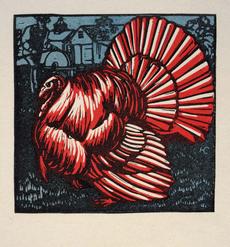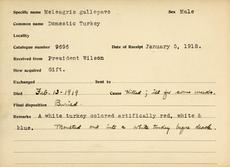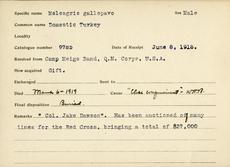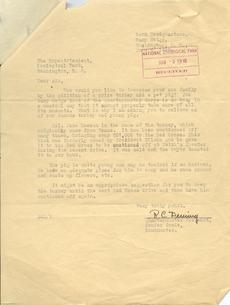 Founding Father Benjamin Franklin once remarked in a letter to his daughter that the turkey would be better suited as America's national symbol than the bald eagle. He wrote, in 1784, "For in Truth the Turkey is in Comparison a much more respectable Bird... He is besides, though a little vain & silly, a Bird of Courage." Today, many laugh about the idea of the turkey as America's national symbol, but perhaps Franklin was on to something.
Founding Father Benjamin Franklin once remarked in a letter to his daughter that the turkey would be better suited as America's national symbol than the bald eagle. He wrote, in 1784, "For in Truth the Turkey is in Comparison a much more respectable Bird... He is besides, though a little vain & silly, a Bird of Courage." Today, many laugh about the idea of the turkey as America's national symbol, but perhaps Franklin was on to something.
 In 1918, when United States was in the midst of World War I, Washington, DC was all a flutter with the introduction of two unlikely patriots or turkeys, who eventually took up residence at the Smithsonian's National Zoological Park.
In 1918, when United States was in the midst of World War I, Washington, DC was all a flutter with the introduction of two unlikely patriots or turkeys, who eventually took up residence at the Smithsonian's National Zoological Park.
The first of these patriotic turkeys arrived in DC by train from Keifer, Oklahoma. J. A. Thomas sent the bird, a white domestic turkey, as a gift to President Woodrow Wilson. Thomas had heard that the East Coast was suffering a turkey shortage and did not want the White House to go without for their Christmas dinner. So the brave turkey, dyed red, white and blue, prepared to make the ultimate sacrifice for the first family. However, fate interceded and the turkey's train was delayed due to railroad congestion, so the bird arrived on January 4, missing the big feast. His fine patriotic feathers impressed the White House and, instead of being the dinner, this multi-colored turkey was given large quarters and a feast on his own. On January 5, President Wilson decided to donate the turkey to the National Zoo where he was placed on exhibit for all to admire.
 The red, white, and blue gobblers' compatriot came to DC in May 1918. Famously known as "Col. Jake Dawson," the domestic turkey hailed from Dawson, Texas, where he helped raise $10,000 in donations for the war effort. In anticipation of a large Red Cross Auction being held in DC, Congressman Rufus Hardy presented President Wilson with "Col. Jake" in hopes that
The red, white, and blue gobblers' compatriot came to DC in May 1918. Famously known as "Col. Jake Dawson," the domestic turkey hailed from Dawson, Texas, where he helped raise $10,000 in donations for the war effort. In anticipation of a large Red Cross Auction being held in DC, Congressman Rufus Hardy presented President Wilson with "Col. Jake" in hopes that he would once again bring in the big bucks. On May 25, "Col. Jake" raised several thousand dollars at the auction. The buyer took the famous "Jake" and donated him to the US Army's Camp Meigs band, so that he could continue to share his patriotism with the public as the band's mascot. However, in June of 1918, Mr. R. C. Deming, Quartermaster Sergeant, Senior Grade, Bandmaster, wrote the Zoo's Superintendent Ned Hollister, that a taxing musical schedule made it difficult for the band to properly take care of "Col. Jake." The Zoo offered to take in the colonel, who was ready for some well deserved rest after raising $37,000 in his fundraising career. Not one to shirk his patriotic duties, "Jake" took up residency with Wilson's red, white and blue turkey, in a pen at the Zoo and the two birds continued to serve their country by bringing joy to Zoo goers.
he would once again bring in the big bucks. On May 25, "Col. Jake" raised several thousand dollars at the auction. The buyer took the famous "Jake" and donated him to the US Army's Camp Meigs band, so that he could continue to share his patriotism with the public as the band's mascot. However, in June of 1918, Mr. R. C. Deming, Quartermaster Sergeant, Senior Grade, Bandmaster, wrote the Zoo's Superintendent Ned Hollister, that a taxing musical schedule made it difficult for the band to properly take care of "Col. Jake." The Zoo offered to take in the colonel, who was ready for some well deserved rest after raising $37,000 in his fundraising career. Not one to shirk his patriotic duties, "Jake" took up residency with Wilson's red, white and blue turkey, in a pen at the Zoo and the two birds continued to serve their country by bringing joy to Zoo goers.
Sadly, the following year, both birds passed away. The famous red, white and blue turkey died after coming down with an illness on February 13, 1919. His friendly fowl, "Col. Jake Dawson," passed away on March 6, 1919, due to issues arising from "close confinement," according to Head Keeper William Blackburne.
Though they did not represent the national symbol, these two colorful birds, helped bring joy to their country. So here is our salute, to the red, white and blue gobbler and his illustrious friend "Col. Jake."
Related Collections
- Record Unit 74 - National Zoological Park, Records, 1887-1966, Smithsonian Institution Archives
- Record Unit 365- National Zoological Park, Office of Public Affairs, Records, 1899-1988 and undated, Smithsonian Institution Archives
- Record Unit 386 - National Zoological Park, Animal Records, 1887-1976, Smithsonian Institution Archives
Produced by the Smithsonian Institution Archives. For copyright questions, please see the Terms of Use.

Leave a Comment